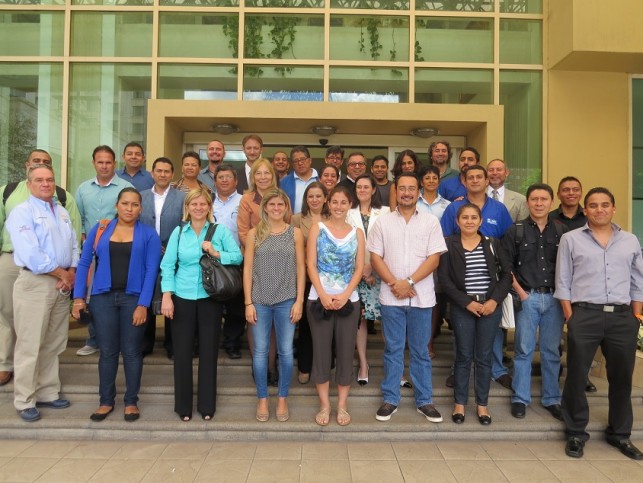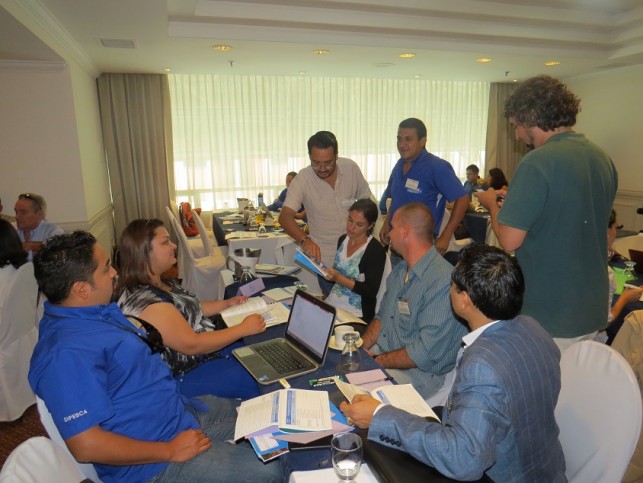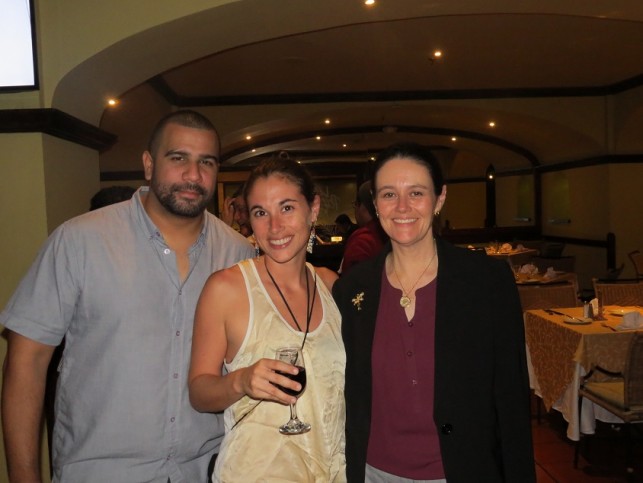by Jen Chapman, Country Coordinator, Belize
One of the main focuses of Blue Ventures’ work in Belize is the monitoring and management of invasive lionfish, Pterois volitans. This Indo-Pacific fish was first spotted off the coast of Florida in the 1980s, and in the year 2000 its population began to boom, reaching Belize in 2008. Its rapid advance across the Caribbean Sea was complete when it was found in Trinidad and Tobago in 2012, by which time lionfish had also successfully established in the Gulf of Mexico, and been found as far north as New York.

The spread of invasive lionfish across the Wider Caribbean [credit: REEF]
On top of this, a lionfish’s body is covered by eighteen venomous spines that are capable of delivering a fatal sting to some fish. This effective defence against natural predation means that the only feasible means for control is consistent, intensive removal efforts by man.
With Belize geographically and culturally straddling both Central America and the Caribbean, within the last month I have attended two lionfish workshops: the first, in Cuba, with a Caribbean focus, and the second, in Guatemala, focussed specifically on the Mesoamerican Reef (MAR) region.

Jen and Alain Garcia Rodriguez, a researcher with the Cuban National Aquarium studying lionfish population status and diet preference in relation to habitat.
The workshop in Cuba, Taller sobre Pez León y Pepino de Mar [Workshop on Lionfish and Sea Cucumber], was organised by INFOPESCA, an intergovernmental organisation which strives to provide information, technical guidance and support for Latin America commercial fisheries advances, in collaboration with the UN’s Food and Agricultural Organisation (FAO), dedicated to the realisation of global food security, the Western Central Atlantic Fishery Commission (COPACO), the regional fisheries body under the FAO, and the Cuban Ministry of Food Industries (MINA). The focus was information exchange, to explore opportunities for these two upcoming fisheries in the Caribbean.
Day one was dedicated to lionfish, and discussions ranged from research into lionfish population recovery rates from intensive removal efforts, to the potential for lionfish to infiltrate European markets. I had the opportunity to discuss the status and barriers for lionfish market development in Belize, as part of Traditional Fisheries’ presentation on lionfish-specific traps. Their prototype trap, with modified facial-recognition software to reduce bycatch, has great potential for deployment in water too deep for divers, where lionfish are large, abundant and (as yet) inaccessible. The lionfish session rounded off with COPACO adopting the Regional Lionfish Strategy, launched in 2012, and a promise from all to implement the strategy in their countries.
The fisheries focus of the workshop was extremely interesting, as it demonstrates a region-wide acceptance that lionfish eradication is not possible. It also means conducting stock assessments, market studies, developing national exploitation strategies and ensuring socioeconomic viability – essential steps to making this fishery real, not just a conservationist’s dream.

Participants of the MARFund workshop in Guatemala, representing government and NGOs in Guatemala, Honduras, Mexico, Belize, as well as some from the Wider Caribbean.
After the workshop, I had the opportunity to explore the city, and found myself falling in love with this country filled with salsa music, delicious coffee, and a very present history. On my last day, as I sat on the side of the road in Old Havana listening to a band play the Buena Vista Club’s classic song, Chan Chan, I reflected on the international misconception of Cuban politics; the openness of the government to hosting a workshop on the use of market-based tools for conservation outcomes (e.g. sustainable seafood labelling, volunteer tourism, carbon credits) possibly demonstrates their changing socialist, rather than communist, approach. *Too political? Haha, just can’t keep my opinions in after visiting such an amazing place.
Less than a month later, I was on my way to more Spanish-immersion, this time in Guatemala City. This workshop was organised by the MARFund, with support from CAR-SPAW-RAC, and ably facilitated by lionfish gurus, Ruben Torres from Reef Check (Dominican Republic) and Ricardo Gómez Lozano from the National Commission of Protected Areas (CONANP) in Mexico. This workshop had the clear objective to refine the Regional Strategy for Lionfish in the Wider Caribbean to the MAR region, something we approached by dividing into themed groups.

Jen and Ricardo consult the Regional Strategy for the Wider Caribbean to develop MAR recommendations.
Group one explored opportunities to facilitate collaboration between government, NGOs, private sector and academia, in order to realise effective cross-boundary management. One recommendation of this group was to form a regional committee, comprising leaders in lionfish management from each of the four countries encompassing the region: Mexico, Belize, Guatemala and Honduras.
The second group focussed on strengthening research and monitoring efforts, and identified a need for studies investigating the socioeconomic side of lionfish: from impacts to fishery viability studies. They also highlighted that lionfish venom may have medicinal uses, which should be further explored!
Group three investigated the need to review legislation to identify potential barriers to lionfish control, as well as endorse best practice guidelines for lionfish control that do not undermine existing conservation strategies. To put this in a Belizean context, there is great concern that lionfish market development will place pressure to reverse the ban on spear guns or fish traps within the General Use Zones of protected areas. In the rush to address the threat of lionfish, it is essential to consider the wider context, and ensure that any and all strategies do not leave another species or system vulnerable.

Samir Rosado, Lead Researcher at Belize’s Coastal Zone Authority and Institute, Jen, and Maria José González, Executive Director of the MARFund
I took part in the fourth group: control methods. The development and promotion of diverse markets for lionfish products and sub-products was the key recommendation, though highlighted the need to identify and develop mechanisms that allows for consistent, intensive removal of lionfish in three marine zones – protected areas, areas open to fishing, and deep sea – each requiring a different approach.
The final group was education and outreach, with the identification of key messages across all four countries forming the primary recommendation. This came out of the confusion caused when campaigns to eat lionfish were coupled with campaigns on how to treat envenomation… everyone agree that we need to couple every outreach event with the information that lionfish is venomous, not poisonous, which means it is safe to eat!
The MAR Lionfish Strategy is planned to be ready for release in November 2014, and in the meanwhile we are all working refining the drafts produced at this extremely productive workshop.
The final evening in Guatemala saw the presentation of the lionfish issue and strategy development in Guatemalan media, followed by a feast of lionfish prepared in a variety of dishes – the favourite was without doubt the thinly-sliced raw lionfish fillet served with a tamarind sauce! Warm Guatemalan hospitality saw the distribution of a taster of Guatemala’s best – Zacapa rum… considering the setting, it also felt appropriate for me to finally learn to dance merengue!


Hi Jen Chapman , was fascinated to see the Simon Reeve Caribbean episode and particularly the part about Belize , following watching this I did a search and found the Blueventures site and the research that you are doing on Lionfish. Several years ago I visited Cuba and was astonished by the country and the people , I now return there every winter and usually stay for several months , I stay in the eastern most part of the island in a town called a Baracoa. During this time I have befriended several spear fisherman ( in Cuba it’s an occupation rather than a hobby) and have seen many Lionfish and heard reports about their abundance in that area , having grown up in Cornwall by the sea I have always had a great interest in marine ecology and fishing , as you will have discovered in your visit to Cuba many things are difficult to buy and I take things like new rubber for the spear fishermen’s harpoon guns. They try to catch as many as they possibly can and it’s good to eat , though it takes some work and care avoiding the spines tomprepare them. I will follow developments on your website with interest and wish that in some way I could be of more help than just a bystander.Keep up the good work , regards Jeremy ?